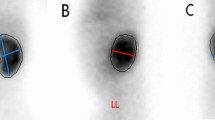Abstract
The existence of supranormal differential renal function in unilateral hydronephrosis remains controversial. While some authors consider it as fact, others believe that it is just a technical artifact. Within our department, chromium-51 ethylene diamine tetra-acetic acid (Cr-EDTA) renal clearance is systematically performed in conjunction with technetium-99m mercaptoacetyltriglycine (MAG3) renograms to derive an absolute single kidney glomerular filtration rate (SKGFR). Our data allows us to ascertain whether supranormal differential renal function in unilateral hydronephrosis might be due to hypofunction of the contralateral kidney. Children with marked unilateral hydronephrosis were selected from a large database of MAG3 diuretic(s) renograms. We excluded patients with posterior urethral valves, duplex anomalies, neurogenic bladder, solitary kidney, and those who underwent any previous urological surgery. We also excluded children who had an early furosemide injection (F0 procedure), selecting only those having received furosemide at the end of the renogram (F+20 test). Seventy-three patients (92 renograms) fulfilled these criteria. Differential renal function was calculated using the integral method. Hydronephrotic kidney with a relative uptake ≥55% was defined as supranormal. Six renograms (four patients) demonstrated supranormal relative function on the hydronephrotic side. However, the SKGFR of these kidneys was in all cases within the range of normal values, while the contralateral side demonstrated borderline low SKGFR. Increased relative function on the side of the hydronephrotic kidney is relatively infrequent. When it occurs, it may be related to a borderline hypofunction of the contralateral kidney.
Similar content being viewed by others
References
Conway JJ (1992) “Well-tempered” diuresis renography: its historical development, physiological and technical pitfalls, and standardized technique protocol. Semin Nucl Med 22:74–84
Blyth B, Snyder HM, Duckett JW (1993) Antenatal diagnosis and subsequent management of hydronephrosis. J Urol 149:693–698
Ransley PG, Dhillon HK, Gordon I, Dillon MJ, Barratt TM (1990)The postnatal management of hydronephrosis diagnosed by prenatal ultrasound. J Urol 144:584–587
Oh SJ, Moon DH, Kang W, Park YS, Park T, Kim KS (2001) Supranormal differential renal function is real but may be pathological: assessment by 99m technetium mercaptoacetyltriglycine renal scan of congenital unilateral hydronephrosis. J Urol 165:2300–2304
Steckler RE, McLorie GA, Jayanthi VR, Gilday DL, Ash JM, Churchill BM, Khoury AE (1994) Contradictory supranormal differential renal function during nuclear renographic investigation of hydroureteronephrosis. J Urol 152:600–602
Groshar D, Issaq E, Nativ O, Livne PM (1996) Increased renal function in kidneys with ureteropelvic junction obstruction: fact or artifact? Assessment by quantitative single photon emission computerized tomography of dimercapto-succinic acid uptake by the kidneys. J Urol 155:844–846
Moon DH, Park YS, Jun NL, Lee SY, Kim KS, Kim JH, Yoon CH, Kang W, Lee HK (2003) Value of supranormal function and renogram patterns on 99mTc-mercaptoacetyltriglycine scintigraphy in relation to the extent of hydronephrosis for predicting ureteropelvic junction obstruction in the newborn. J Nucl Med 44:725–731
Capolicchio G, Jednak R, Dinh L, Salle JL, Brzezinski A, Houle AM (1999) Supranormal renographic differential renal function in congenital hydronephrosis: fact, not artifact. J Urol 161:1290–1294
Gluckman GR, Baskin LS, Bogaert GA, Mevorach RA, Hattner RS, Kogan BA (1995) Contradictory renal function measured with mercaptoacetyltriglycine diuretic renography in unilateral hydronephrosis. J Urol 154:1489–1490
Fung LC, McLorie GA, Khoury AE, Ash JM, Gilday DL, Churchill BM (1995) Contradictory supranormal nuclear renographic differential renal function: fact or artifact? J Urol 154: 667–670
Gordon I, Colarinha P, Fettich J, Fischer S, Frokier J, Hahn K, Kabasakal L, Mitjavila M, Olivier P, Piepsz A, Porn U, Sixt R, van Velzen J (2001) Guidelines for standard and diuretic renography in children. Eur J Nucl Med 28:BP21–30
Piepsz A, Hahn K, Roca I, Ciofetta G, Toth G, Gordon I, Kolinska J, Gwidlet J (1990) A radiopharmaceuticals schedule for imaging in paediatrics. Paediatric Task Group European Association Nuclear Medicine. Eur J Nucl Med 17:127–129
Prigent A, Cosgriff P, Gates GF, Granerus G, Fine EJ, Itoh K, Peters M, Piepsz A, Rehling M, Rutland M, Taylor A Jr (1999) Consensus report on quality control of quantitative measurements of renal function obtained from the renogram: International Consensus Committee from the Scientific Committee of Radionuclides in Nephrourology. Semin Nucl Med 29:146–149
Blaufox MD, Aurell M, Bubeck B, Fommei E, Piepsz A, Russell C, Taylor A, Thomsen HS, Volterrani (1996) Report of the Radionuclides in Nephrourology Committee on Renal Clearance. J Nucl Med 37:1883–1890
Piepsz A, Pintelon H, Ham HR (1994) Estimation of normal chromium-51 ethylene diamine tetra-acetic acid clearance in children. Eur J Nucl Med 21:12
Peters CA, Carr MC, Lais A, Retik AB, Mandell J (1992):The response of the fetal kidney to obstruction. J Urol 148: 503–509
Inanir S, Biyikli N, Noshari O, Caliskan B, Tugtepe H, Erdil TY, Akpinar I, Kiyan G, Alpay H (2005) Artefactual supranormal renal function on MAG3 scan. Eur J Nucl Med 30 [Suppl 2]:91–96
Khan J, Charron M, Hickeson MP, Accorsi R, Qureshi S, Canning D (2004.) Supranormal renal function in unilateral hydronephrotic kidney can be avoided. Clin Nucl Med 29:410–414
Granerus G, Moonen M, Ekberg S (1991) A comparison between Tc-99m MAG3 and Tc-99m DTPA with special reference to the measurement of relative and absolute renal function. In: Schmidt HAE, van der Schoot JB (eds). Nucear Medicine. The state of the art of nuclear medicine in Europe. Schattauer, Stuttgart, pp 284
Author information
Authors and Affiliations
Corresponding author
Rights and permissions
About this article
Cite this article
Maenhout, A., Ham, H., Ismaili, K. et al. Supranormal renal function in unilateral hydronephrosis: does it represent true hyperfunction?. Pediatr Nephrol 20, 1762–1765 (2005). https://doi.org/10.1007/s00467-005-2049-8
Received:
Revised:
Accepted:
Published:
Issue Date:
DOI: https://doi.org/10.1007/s00467-005-2049-8




